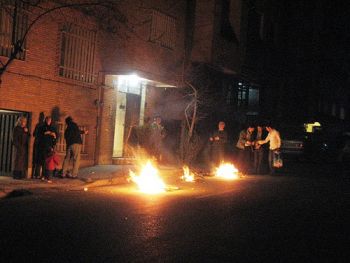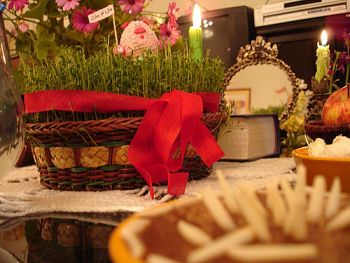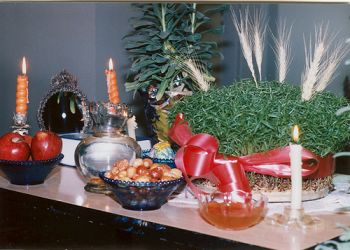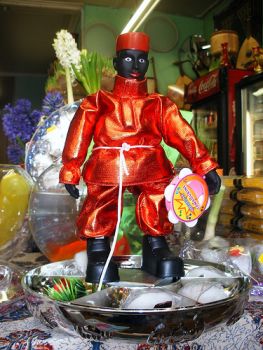Noruz
Noruz or Nowruz is a traditional festival organized to mark the Iranian New Year. This festival is celebrated on the 20th, 21st and 22nd of March. A month before the New Year Iranian women thoroughly clean their homes. This act is called “Khouneh Tekouni” (“shaking the house”).
One of the most important events before Noruz is “Chaharshanbe-Soori” (Fire Festival). This festival is held on the last Wednesday night of the year. The festival celebrates the victory of “light” (good) over “darkness” (evil).
 Chaharshanbe-Soori (Fire Festival)
Chaharshanbe-Soori (Fire Festival)
Special bonfires are made in the streets. Jumping over such fires is a popular custom. People sing traditional song “Zardî-ye man az (ane) to, sorkhî-ye to az (ane) man” ("My yellowness is yours, your redness is mine"). There is a local belief that the fire can take all the bad things of the passing year and give you the strength for the new year. On the Fire Festival people prepare food like for example nuts called “Ajīl-e Moshkel-Goshā” (“problem-solving nuts”).
There is a local belief stating that souls of the deceased often visit their former homes on the last days of the year. Kids wearing shrouds remind their neighbourhood of those visits. Kids bang pots with spoons and go door to door asking for presents. This tradition is called “qashogh-zany” (“spoon beating”).
Last Wednesday night of the year is also time for the tradition called “Kūze Shekastan.” People break clay jars as it is believed that they contain bad luck. The last Thursday night or the last Friday morning of the year is the time when Iranians visit their cemeteries. Muslims read the Sura Al-Fatiha for the deceased family members.
 Sabzeh
Sabzeh
In the days before New Year Iranian people buy new clothes, buy flowers (tulips, hyacinth) and grow “Sabzeh.” The Sabzeh is traditional growing of cereal seedlings. Nowadays a month before Noruz a housewife takes several handfuls of seeds. Number of handfuls depends on the number of family members. When putting each handful of seeds in a clay pot filled with water the housewife wishes them good health and prosperity. They stay there until they sprout. After that they are put on a copper plate, covered with a cloth and sprayed with some water. When Sabzeh turns green, a red ribbon is put placed on it.
In the past Iranians used to make 12 brick (made of mud) columns. They represented 12 months of the year. Between these columns people put seeds of certain plants like wheat, barley, bean, millet, chickpea, sesame etc.
On the 16th of Farvardin (5th of April) the family members traditionally analyse the plants that have grown from the seeds. The tallest one is then cultivated in the coming season.
 Haft Sîn
Haft Sîn
With the approach of New Year people prepare a specially decorated table. According to a very old tradition seven objects (“Haft Sîn” or “the seven 'S's”) are put on the table. These objects are
- “Serkeh” (vinegar) symbolizes old-age and patience
- “Seeb” (apples) symbolizes beauty and health
- “Seer” (garlic) symbolizes medicine
- “Senjed” (dried oleaster fruit) symbolizes love
- “Somaq” (sumac) symbolizes the color of sunrise
- “Samanu” (sweet pudding made from wheat germ) symbolizes affluence
- “Sabzeh” symbolizes rebirth.
Sometimes people add few other objects like for example “sekeh” or coins which symbolize prosperity. As request for the God's blessing Muslims put holy Quran and Zoroastrians put the Avesta. As the New Year approaches family members, wearing new clothes, gather around the Haft Sîn table and pray.
With the arrival of New Year people congratulate each other. Then the father or the oldest family members gives everyone their “Eidi” (New Year present). During Noruz people visit their relatives. Lot of delicious food is prepared. One of dishes prepared for the occasion is “Sabzi Polo Mahi.” It is made of rice with herbs served with fish. The celebration of the New Year lasts for 12 days. On the thirteenth day families have a picnic. This day is called “Sizdah Bedar.”
 Haji Firouz
Haji Firouz
Finally, let's mention “Haji Firouz” or “Khwaja Piruz.” He is a traditional creature of the Nowruz time in Iran. He represents the rebirth of Domuzi, the Sumerian god of sacrifice. According to an ancient belief he is killed at the end of year and then being born at the beginning of the new year. Haji Firouz wears a red clothes. His face is black. The black is chosen as this symbolizes good luck. He traditionally sings and dances down the street announcing the arrival of new year.